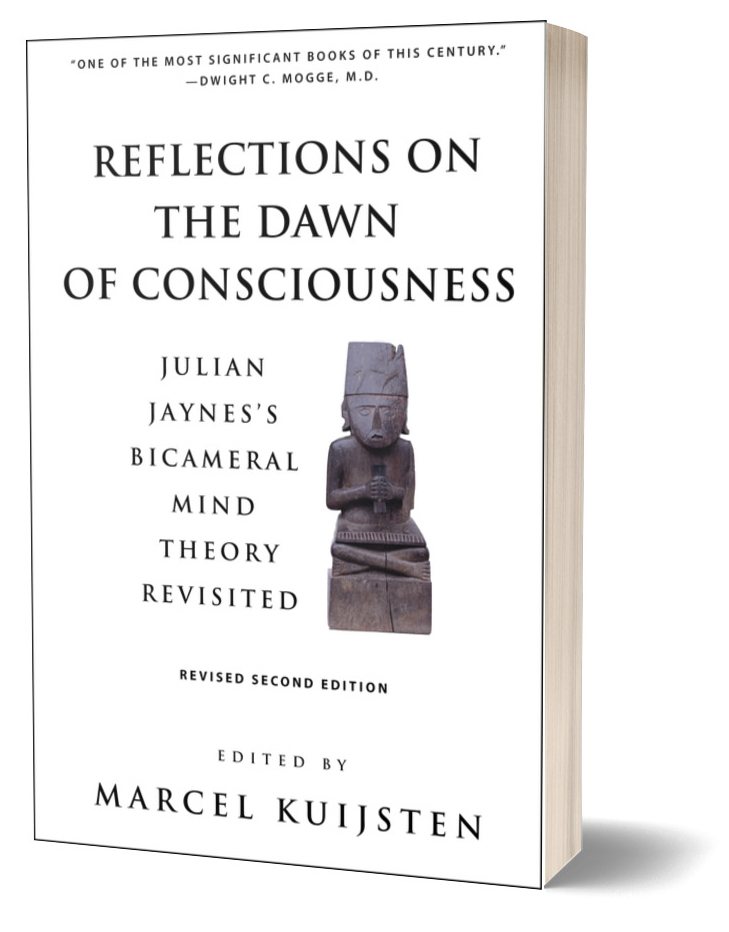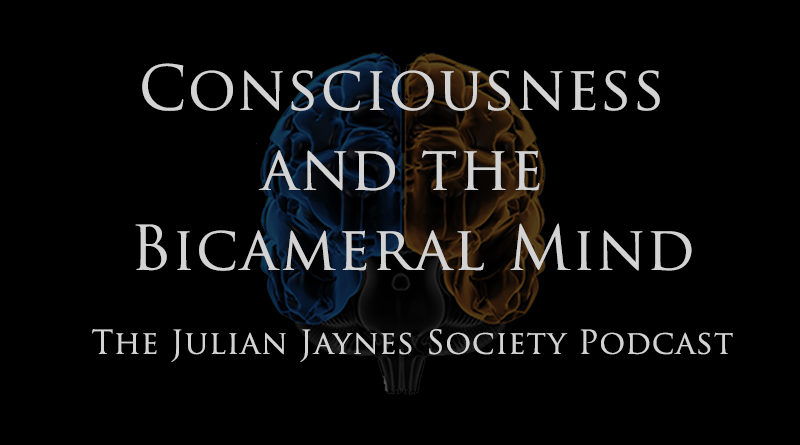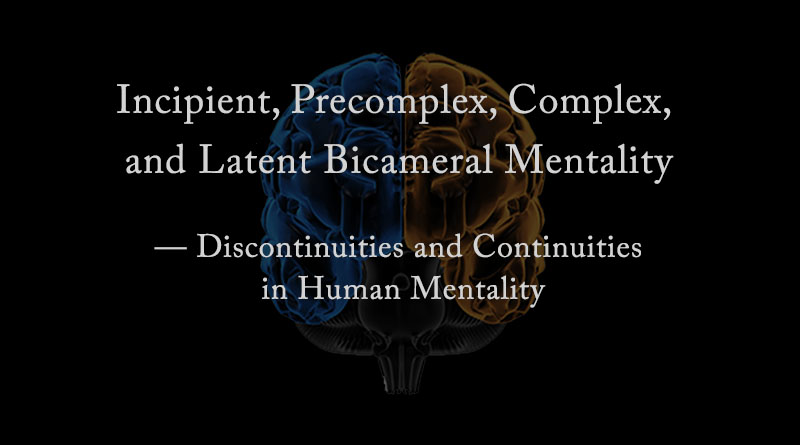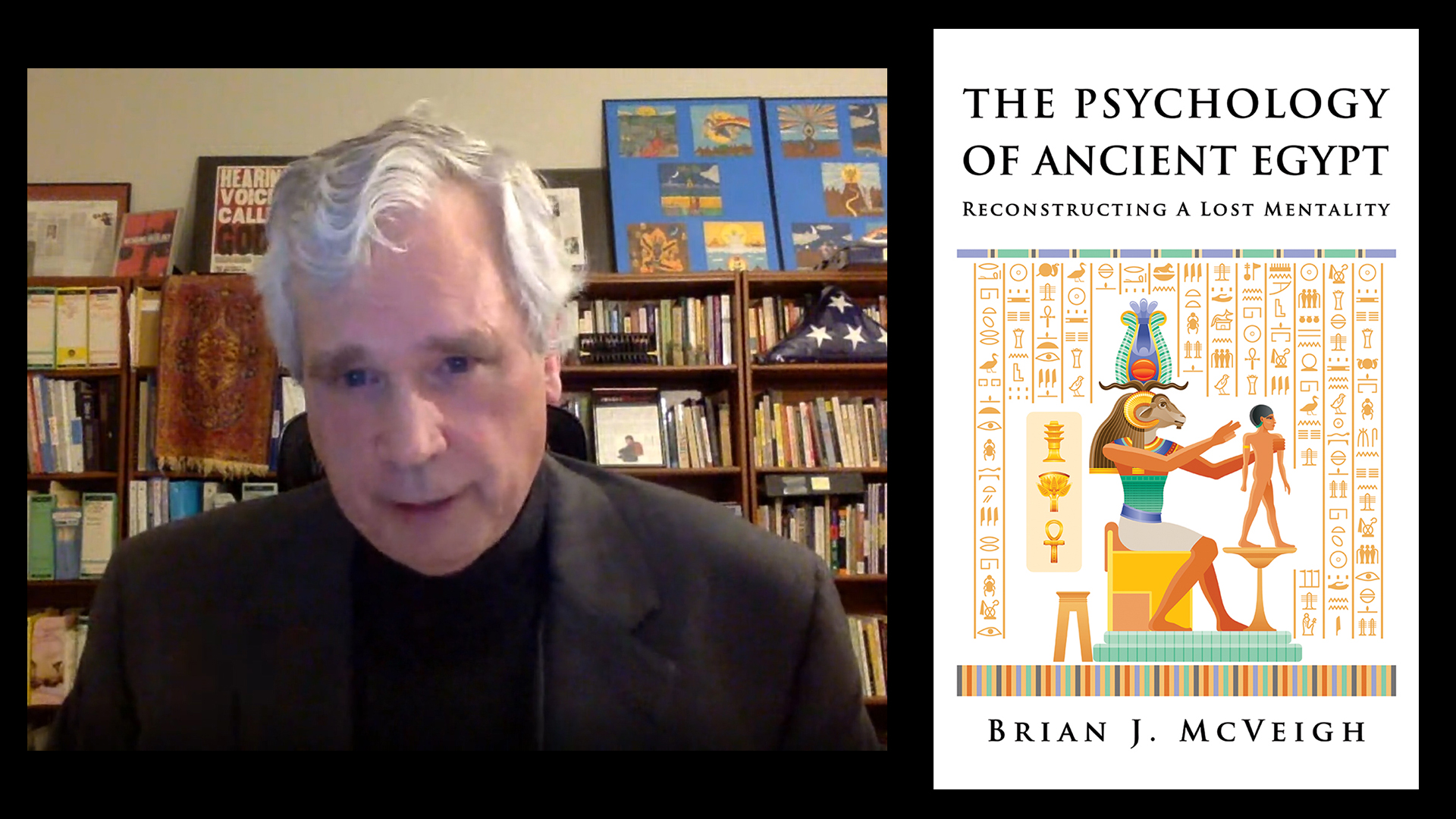In Case You Missed It…
Important Julian Jaynes Society updates and developments that you might have missed… also be sure to check out our latest blog posts in the menu to the right.
Sign up for our mailing list and follow us on Facebook, Twitter, and YouTube for the latest updates.
March 2024
Read the Spring 2024 Newsletter.
Not on our mailing list? Sign up here: Join Our Mailing List.
Subscribe to “Consciousness and the Bicameral Mind,” the Julian Jaynes Society podcast.
February 2024
Read the second revised edition of Reflections on the Dawn of Consciousness, now available worldwide.
November 2023
RSVP for this upcoming event:
The Psychology of Ancient Egypt with Brian J. McVeigh, November 16, 2022
October 2023
New for supporters: Watch Julian Jaynes present his ideas to science-oriented children at the Talcott Mountain Science Center.
September 2023
Read The Psychology of Ancient Egypt: Reconstructing A Lost Mentality, by Brian J. McVeigh, just published by the Julian Jaynes Society.
As of September 3rd, Amazon is running a flash sale on our latest book, Conversations on Consciousness and the Bicameral Mind. Take advantage of this very low price while it lasts! https://www.amazon.com/gp/product/1737305534
Read our Fact Checks of psychiatrist Dr. Scott Alexander’s review of Julian Jaynes’s theory.
August 2023
Read the Summer 2023 Newsletter.
Not on our mailing list? Sign up here: Join Our Mailing List.
Read our latest book, Conversations on Consciousness and the Bicameral Mind, on sale through the September 8th.
Read “Consciousness as ‘Super-perception‘” by Brian J. McVeigh on the JJS Blog.
Read “Fact Checking Erik Hoel’s The World behind the World: Consciousness, Free Will, and the Limits of Science” by Brian J. McVeigh on the JJS Blog.
Watch “Julian Jaynes and Owen Barfield on the Origins, Nature & Trajectory of Consciousness” on the JJS YouTube channel.
June 2023
Watch “Stanford Anthropology Professor Discusses Julian Jaynes’ Theory” on the JJS YouTube channel.
May 2023
Read the Spring 2023 Newsletter.
Not on our mailing list? Sign up here: Join Our Mailing List.
March 2023
Watch “The Gods of Mesopotamia and the Presentist Fallacy” on the JJS YouTube channel.
February 2023
Read “Consciousness Is More ‘Nurture’ than ‘Nature'” by Brian J. McVeigh on the JJS Blog.
Watch “The Why, What, and How of Human Consciousness” on the JJS YouTube channel.
Watch “How Languages Create Mind Space and the ‘Analog I’“ on the JJS YouTube channel.
Watch “The Emergence of Psychotherapies in Modern Japan: A Jaynesian Interpretation” on the JJS YouTube channel.
January 2023
Watch “A Bicameral Semiotic: The Linguistic Sign as Image-Word Dyad” on the JJS YouTube channel.
December 2022
Read the November/December Newsletter.
Not on our mailing list? Sign up here: Join Our Mailing List.
Read “Falling between the Cracks” by Brian J. McVeigh on the JJS Blog.
Watch “Q&A Session on “Conversations on Consciousness and the Bicameral Mind” Part 1: Iliad/Odyssey/Sinuhe” on the JJS YouTube channel.
Watch “An Encounter of Julian Jaynes & Jacques Derrida: Consciousness, Divine Voice & Writing” on the JJS YouTube channel.
October 2022
RSVP for this upcoming event:
Q&A on Julian Jaynes’s Theory plus Conversations on Consciousness and the Bicameral Mind Book Discussion, November 5, 2022
Read our latest book, Conversations on Consciousness and the Bicameral Mind, on sale through the end of October.
Read “The Myth of “Pure Consciousness” by Brian J. McVeigh on the JJS Blog.
Read the September/October 2022 Newsletter.
Not on our mailing list? Sign up here: Join Our Mailing List.
September 2022
Read “Animal Minds? Yes. Animal Consciousness? No.” by Brian J. McVeigh on the JJS Blog.
New articles, a new interview, and a new lecture by Gregory Conrow from the Julian Jaynes Society Conference on Consciousness and Bicameral Studies posted in the Member Area. Log in or Sign up.
August 2022
Our latest book, Conversations on Consciousness and the Bicameral Mind, was published on August 22! All pre-orders were shipped in early August and the book is now available for immediate shipping. It is also available on Amazon sites worldwide and via special order from most bookstores.
If you’ve already enjoyed the book, please take a moment to write a positive review on our website, Amazon, and Goodreads. We appreciate your support!
Watch “David Duchovny Explains Julian Jaynes’s Theory to Bill Maher” on the Related Interviews page.
Read the August 2022 Newsletter.
Not on our mailing list? Sign up here: Join Our Mailing List.
July 2022
Test your knowledge of Julian Jaynes’s theory by taking our three new quizzes.
Read “Consciousness Is the Word Preventing People from Understanding Jaynesian Psychology” by Brian J. McVeigh on the JJS Blog.
Read the July 2022 Newsletter.
Not on our mailing list? Sign up here: Join Our Mailing List.
A new documentary on preliterate societies, new Q&A, and a new lecture by Eric Alexander La Freniere from the Julian Jaynes Society Conference on Consciousness and Bicameral Studies posted in the Member Area. Log in or Sign up.
June 2022
The Julian Jaynes Society is honored to welcome Dr. Clive Svendsen to the Science Advisory Board.
Pre-order our latest book: Conversations on Consciousness and the Bicameral Mind
Read the May/June 2022 Newsletter.
Not on our mailing list? Sign up here: Join Our Mailing List.
Watch the latest interviews on Julian Jaynes’s theory:
https://www.youtube.com/watch?v=EeoNH7dTwZc
https://www.youtube.com/watch?v=tAE5WL5XvDQ
https://www.youtube.com/watch?v=NvIPCV_hCAY
Read “Julian Jaynes Is Not for the Intellectually Fainthearted” by Brian J. McVeigh on the JJS Blog.
New articles, dissertations, and a new lecture by Terryl Atkins from the Julian Jaynes Society Conference on Consciousness and Bicameral Studies posted in the Member Area. Log in or Sign up.
April 2022
Pre-order our latest book: Conversations on Consciousness and the Bicameral Mind
Read the Spring 2022 Newsletter.
Not on our mailing list? Sign up here: Join Our Mailing List.
Read “The Need to Acknowledge Bicameral Vestiges” by Brian J. McVeigh on the JJS Blog.
New articles, dissertations, and a new lecture by Roy Baumeister from the Julian Jaynes Society Conference on Consciousness and Bicameral Studies posted in the Member Area. Log in or Sign up.
December 2021
Read the November/December 2021 Newsletter.
Not on our mailing list? Sign up here: Join Our Mailing List.
A newly discovered interview with Julian Jaynes, new related articles, and a lecture from the Julian Jaynes Society Conference on Consciousness and Bicameral Studies posted in the Member Area. Log in or Sign up.
“They Were Noble Automatons Who Knew Not What They Did:” Volition in Jaynes’ The Origin of Consciousness in the Breakdown of the Bicameral Mind, by James W. Moore
October 2021
New articles, interviews, lectures, and new lectures from the Julian Jaynes Society Conference on Consciousness and Bicameral Studies posted in the Member Area. Log in or Sign up.
Read the September/October 2021 Newsletter.
Not on our mailing list? Sign up here: Join Our Mailing List.
September 2021
A new lecture by Julian Jaynes, new articles, dissertations, and a new lecture from the Julian Jaynes Society Conference on Consciousness and Bicameral Studies posted in the Member Area. Log in or Sign up.
August 2021
New articles and a new lectures from the Julian Jaynes Society Conference on Consciousness and Bicameral Studies posted in the Member Area. Log in or Sign up.
Read the July/August 2021 Newsletter.
Not on our mailing list? Sign up here: Join Our Mailing List.
July 2021
The Julian Jaynes Society is honored to welcome Professor Martin Seligman to the Science Advisory Board:
Professor Seligman is the Zellerbach Family Professor of Psychology and Director of the Positive Psychology Center at the University of Pennsylvania, where he focuses on positive psychology, learned helplessness, prospection, optimism and positive education. He is a best-selling author of several books, including Flourish. His most recent book is The Hope Circuit, his autobiography.
Read more about Professor Seligman.
New lectures from the Julian Jaynes Society Conference on Consciousness and Bicameral Studies posted in the Member Area. Log in or Sign up.
June 2021
The hardcover edition of Der Ursprung des Bewußtseins durch den Zusammenbruch der Bikameralen Psyche (the German edition of Julian Jaynes’s The Origin of Consciousness in the Breakdown of the Bicameral Mind) is now available in Germany (also serving many other EU countries), France, Italy, Spain & Portugal, the United States, and the United Kingdom.
New lectures from the Julian Jaynes Society Conference on Consciousness and Bicameral Studies and our May 2021 Q&A Session posted in the Member Area. Log in or Sign up.
May 2021
We are pleased to announce that the revised hardcover edition of The Julian Jaynes Collection has just been released in the United States, France, Germany (also serving many other EU countries),, Italy, Spain & Portugal, and United Kingdom. It will soon be available for order wherever books are sold. This beautifully produced book has the cover art printed right on the case, similar to a textbook, so no dust jacket to lose or get torn. Perfect for Jaynes enthusiasts, collectors, and libraries.
The Julian Jaynes Society is honored to welcome Professor Edoardo Casiglia and Professor Laurence Sugarman to the Science Advisory Board:
– Professor Casiglia, MD, is Professor of Internal Medicine at University of Padova, Italy. He is a specialist in cardiology, pharmacology, anesthesia and intensive care, a clinical hypertension specialist, and an anthropologist and forensic archeologist.
– Professor Sugarma, MD, is Research Professor and Director of the Center for Applied Psychophysiology and Self-regulation in the College of Health Sciences and Technology at the Rochester Institute of Technology (RIT); a developmental and behavioral pediatrician at the Easter Seals Diagnostic and Treatment Center in Rochester, New York; and Clinical Professor in Pediatrics at the University of Rochester School of Medicine and Dentistry.
Read more about Professor Casiglia and Professor Sugarman.
The hardcover edition of La naissance de la conscience dans l’effondrement de l’esprit bicaméral (the French edition of Julian Jaynes’s The Origin of Consciousness in the Breakdown of the Bicameral Mind) is now available in France, Germany (also serving many other EU countries), Italy, Spain & Portugal, the United States, and the United Kingdom.
Read the May 2021 Newsletter.
Not on our mailing list? Sign up here: Join Our Mailing List.
April 2021
RSVP for this Upcoming Event:
Q&A on Julian Jaynes’s Theory with Marcel Kuijsten, Brian McVeigh, and Special Guests, May 1, 2021
Watch the interview with Boban Dedovic: “The Evolution of Mind Words in the Iliad and the Odyssey“ (Julian Jaynes Society Interview Series). Log in or Sign up.
We are pleased to announce that the hardcover edition of Gods, Voices, and the Bicameral Mind has just been released in the United States, France, Germany, Italy, Spain, and United Kingdom. It will soon be available for order wherever books are sold. This beautifully produced book has the cover art printed right on the case, similar to a textbook, so no dust jacket to lose or get torn. Perfect for Jaynes enthusiasts, collectors, and libraries.
“The Voice In Your Head,” by Sophie McBain, with discussion of Julian Jaynes’s bicameral mind theory and Jaynes’s influence on the Hearing Voices Movement.
Read the April 2021 Newsletter.
Not on our mailing list? Sign up here: Join Our Mailing List.
March 2021
RSVP for this Upcoming Event:
Boban Dedovic – The Evolution of Mind Words in the Iliad and the Odyssey, March 20, 2021
Read the March 2021 Newsletter.
Not on our mailing list? Sign up here: Join Our Mailing List.
February 2021
Watch the interview with Brian J. McVeigh: “Evidence for the Bicameral Mind in the Old Testament” (Julian Jaynes Society Interview Series). Log in or Sign up. Watch the preview on YouTube.
Did the Bicameral Mind Evolve to Create Modern Human Consciousness?
Read the February 2021 Newsletter.
Not on our mailing list? Sign up here: Join Our Mailing List.
We’ve dramatically expanded our global distribution for all Julian Jaynes Society Publications. Julian Jaynes Society books can now be ordered in many bookstores worldwide through their normal distribution channels.
January 2021
We’ve released updated versions of all of our Kindle publications. To get the latest version, log in to your Amazon account, go to “Manage content and devices,” and look for the “Update available” link under the book title.
See JJS Publications here:
https://www.julianjaynes.org/product-category/publications/
https://www.julianjaynes.org/product-category/publications-foreign/
Watch a new Interview with Marcel Kuijsten and Brian J. McVeigh on Julian Jaynes’s theory.
Additional lectures from the Julian Jaynes Society Conference on Consciousness and Bicameral Studies posted in the Member Area. Log in or Sign up to view.
Read the January 2021 Newsletter.
Not on our mailing list? Sign up here: Join Our Mailing List.
The softcover edition of El origen de la conciencia en la ruptura de la mente bicameral (the Spanish edition of Julian Jaynes’s The Origin of Consciousness in the Breakdown of the Bicameral Mind) is now available in Spain and 8 other markets: Australia, Canada, France, Germany, Italy, Japan, Spain & Portugal, United States, United Kingdom
December 2020
Watch The Voices in Your Head: How God Became ‘I’ – An interview with Brian J. McVeigh on his latest book and Julian Jaynes’s theory.
The softcover edition of Der Ursprung des Bewußtseins durch den Zusammenbruch der Bikameralen Psyche (the German edition of Julian Jaynes’s The Origin of Consciousness in the Breakdown of the Bicameral Mind) is now available in Germany and 8 other markets: Australia, Canada, France, Germany, Italy, Japan, Spain & Portugal, United States, United Kingdom
November 2020
The softcover edition of La naissance de la conscience dans l’effondrement de l’esprit bicaméral (the French edition of Julian Jaynes’s The Origin of Consciousness in the Breakdown of the Bicameral Mind) is now available in France, Canada, and 7 other markets: Australia, Canada , France
Germany, Italy, Japan, Spain & Portugal, United States, United Kingdom
October 2020
A rare audio lecture by Julian Jaynes posted in the Member Area. Log in or Sign up to listen.
El origen de la conciencia en la ruptura de la mente bicameral (the Spanish edition of Julian Jaynes’s The Origin of Consciousness in the Breakdown of the Bicameral Mind) is now available for Kindle on all Amazon sites worldwide.
September 2020
Rare video of Julian Jaynes’s giving his lecture, “Consciousness and the Voices of the Mind,” posted in the Member Area, along with additional videos from the Julian Jaynes Society Conference on Consciousness and Bicameral Studies. Log in or Sign up to view.
New book: The Psychology of the Bible: Explaining Divine Voices and Visions by Brian J. McVeigh.
August 2020
Lectures from the Julian Jaynes Society Conference on Consciousness and Bicameral Studies posted in the Member Area. Log in or Sign up to view.
June 2020
Neuroscience Confirms Julian Jaynes’s Neurological Model
February 2020
In celebration of Julian Jaynes’s 100th birthday, we officially launched the completely redesigned Julian Jaynes Society website and Member Area. The new site has greatly improved functionality, features, security, a better user experience, new content, and is optimized for both computers and mobile devices. Special thanks to JJS member Boban Dedovic for volunteering his time and expertise to this project. Thank you also to the Julian Jaynes Society members — your ongoing support helped make this project possible!
May 2019
Julian Jaynes’s The Origin of Consciousness in the Breakdown of the Bicameral Mind is now available in Korean.
Expanded to include a new, previously unpublished 30-page in-depth interview with Julian Jaynes, the softcover edition of The Julian Jaynes Collection is now available in the U.S. as well as 8 other markets: Australia, Canada, France, Germany, Italy, Japan, Spain & Portugal, United Kingdom
The softcover edition of Gods, Voices, and the Bicameral Mind is now available for direct purchase in the U.S., Canada, and 7 new overseas markets:
Australia, Canada, France, Germany, Italy, Japan, Spain & Portugal, United States, United Kingdom
March 2019
The Julian Jaynes Collection Kindle Edition is now available on all Amazon sites worldwide.
February 2019
The Gods, Voices, and the Bicameral Mind Kindle Edition is now available on all Amazon sites worldwide.
January 2018
The 20th Anniversary of the Julian Jaynes Society
January 2018
New book: The ‘Other’ Psychology of Julian Jaynes: Ancient Languages, Sacred Visions, and Forgotten Mentalities by Brian J. McVeigh.
September 2017
La naissance de la conscience dans l’effondrement de l’esprit bicaméral (the French edition of Julian Jaynes’s The Origin of Consciousness in the Breakdown of the Bicameral Mind) is now available for Kindle on all Amazon sites worldwide.
May 2017
The Why Factor: Why Do We Talk to Ourselves?
Includes discussion of Julian Jaynes’s theory with Julian Jaynes Society Executive Director Marcel Kuijsten.
April 2017
Der Ursprung des Bewusstseins durch den Zusammenbruch der Bikameralen Psyche (the German edition of Julian Jaynes’s The Origin of Consciousness in the Breakdown of the Bicameral Mind) is now available for Kindle on all Amazon sites worldwide.
January 2017
Celebrating the 10 Year Anniversary of our first book, Reflections on the Dawn of Consciousness.
December 2016
The Trippy Theory of Consciousness at the Heart of Westworld
October 2016
The Bicameral Mind Explains What’s Next for “Westworld”
Interview with Executive Director Marcel Kuijsten on Julian Jaynes’s Theory and Westworld.
Why The Bicameral Mind Theory Is Crucial To Unlocking “Westworld”
July 2015
The Origin of Consciousness in the Breakdown of the Bicameral Mind Audible version is now available.
May 2014
Now available: The 2013 Julian Jaynes Society Conference on Consciousness and Bicameral Studies Audio CD.
December 2013
The Reflections on the Dawn of Consciousness Kindle Edition is now available on all Amazon sites worldwide.
November 2012
The Origin of Consciousness in the Breakdown of the Bicameral Mind Kindle Edition is now available.





